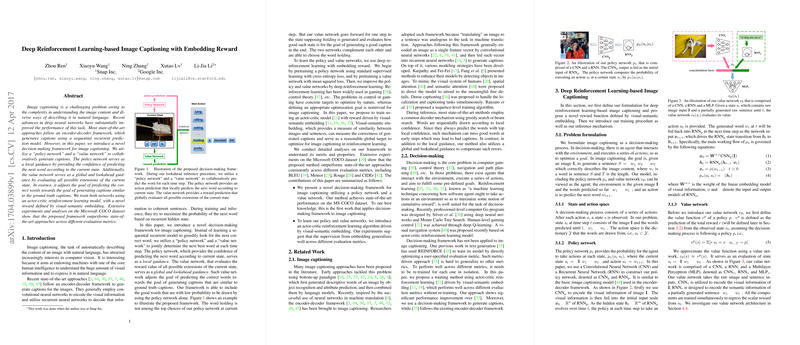Overview of Deep Reinforcement Learning-based Image Captioning with Embedding Reward
The paper "Deep Reinforcement Learning-based Image Captioning with Embedding Reward" introduces an innovative approach to image captioning by employing a decision-making framework incorporating a policy network and a value network. The authors propose a reinforcement learning method, driven by a visual-semantic embedding reward, to enhance the generation of captions that are semantically closer to human-generated descriptions of images.
Image captioning remains a complex challenge in computer vision due to the intricacies involved in understanding image content and the variability in natural language descriptions. The proposed method departs from traditional encoder-decoder frameworks, prevailing in the field, and introduces a novel mechanism utilizing reinforcement learning.
The fundamental components of their model include a "policy network" and a "value network." The policy network establishes the likelihood of predicting the next word from a given state, providing local guidance during the caption generation process. Conversely, the value network offers global or lookahead guidance by assessing the potential extensions of the current state to emulate human-like captions better. The integration of these networks, through an actor-critic method, enhances the system's decision-making capabilities.
Methodological Advancements
The primary contributions are twofold:
- Framework Innovation: By employing a decision-making framework instead of the conventional sequence prediction models, the system evaluates and selects the next word based not only on immediate predictions (policy network) but also on future state evaluations (value network). This is a notable shift from purely probability-driven methods to a more strategic decision-making process.
- Actor-Critic Reinforcement Learning with Embedding Reward: The paper utilizes a specific type of reinforcement learning to optimize the network parameters. The reward is based on visual-semantic embeddings, providing a holistic metric for evaluating how well the generated captions align with the ground truth. The embedding model learns a unified mapping for images and captions, ensuring consistent evaluation across different metrics.
Empirical Results
The system demonstrates superior performance relative to existing models on the Microsoft COCO dataset, showcasing improvements across various metrics such as BLEU, Meteor, Rouge-L, and CIDEr. The ablation studies included in the paper highlight the advantages of the decision-making framework, particularly the efficacy of the lookahead inference mechanism.
The reported numerical results decisively indicate that the combination of locally-informed policy decisions and globally-assessed value predictions yields a significant performance boost. The paper also examines parameter sensitivity, particularly the impact of hyperparameter tuning and beam sizes, underscoring the robustness and adaptability of the proposed method.
Implications and Future Prospects
The introduced framework not only achieves empirical gains but also symbolizes a conceptual evolution towards more sophisticated AI-guided language generation methods. The adoption of decision-making principles in a traditionally sequential task opens new avenues for enhancing the interpretability and adaptability of AI systems, especially in natural language processing and multimedia understanding.
The research evidences a promising direction for future exploration, where refining the architecture of the value network or experimenting with alternative embedding-based reward structures could further advance the capabilities of image captioning systems. Moreover, the potential integration with broader AI decision-making frameworks, such as those used in autonomous systems and gaming, could amplify its applicability and impact.
Overall, the paper presents significant contributions to the field of image captioning, offering a robust framework that paves the way for more complex decision-making processes in AI-driven language generation tasks.
